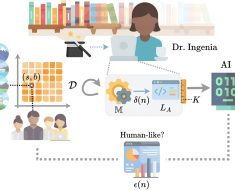Artificial Intelligence (AI) and Machine Learning (ML) are drastically transforming our perception of intelligence. One intriguing experiment trending recently is the so-called “Reverse Turing Test,” where AI and human participants try to uncover the hidden human among AI entities. The video, Could YOU Fool a Room of AIs?, dives deep into this concept, elevating discussions about the future of AI and its limitations.
The Challenge: Fooling the AIs
In this fascinating setup, five characters are on a train — four AI-driven personas and one human, all modeled after historical figures like Aristotle, Cleopatra, and Genghis Khan. All characters engage in philosophical discussions, with the goal of identifying the sole human among them. The human blends among the AI by embodying the persona of Genghis Khan, while sophisticated language models like GPT-4 and GEMINI simulate the responses of historical figures.
Key Moments and Revelations
The AI characters ask penetrating questions aimed at finding the human. Each character’s response, such as Leonardo da Vinci delving into the synergy of art and science, is scrutinized for signs of humanity. Remarkably, the AI-driven participants themselves engage in identifying nuanced distinctions in speech patterns and vocabulary, indicating their difference from humans.
This Reverse Turing Test reveals critical insights into the capabilities and limitations of current AI models. But what does it really tell us about Artificial General Intelligence (AGI)?
Is This Proper AGI?
One of the most debated aspects of AI is whether we are close to achieving AGI — a machine with human-like cognitive abilities. This experiment showcases both the advancements and the inherent limitations of AI. While AI models can generate coherent, contextually appropriate responses, they often lack the intuitive depth that characterizes genuine human emotions and insights.
Critics argue that despite impressive capabilities, these AIs only simulate understanding rather than truly possess it. Terms like “tapestry” and an over-structured articulation reveal the mechanical underpinnings of their responses, raising questions about the nature of AI consciousness and creativity.
Controversial Opinions and Challenges
- Over-Reliance on Training Data: The experiment highlights a fundamental issue — AI’s reliance on pre-existing data. AI models are trained on massive datasets, but their responses are inherently limited to the scope of this training. This over-reliance can lead to superficial mimicry rather than genuine understanding.
- Ethical Concerns: The ability of AI to convincingly impersonate humans raises ethical questions. Should AI systems be allowed to blend seamlessly into human interaction contexts? What safeguards are necessary to prevent misuse?
- Limits of AI Creativity: Despite their advanced algorithms, the AIs’ responses often fell into predictable patterns. This begs the question: Can AI ever truly innovate or create in the same way humans do?
Future Implications
As AI models evolve, experiments like the Reverse Turing Test will become ever more critical in understanding the real potential and boundaries of AI. They push us to reconsider what it means to be intelligent and creative, urging us to approach AGI with both excitement and caution.
To watch the original video and see how the participants navigated the complexities of fooling AI, click here.



